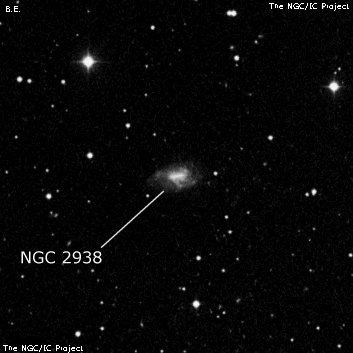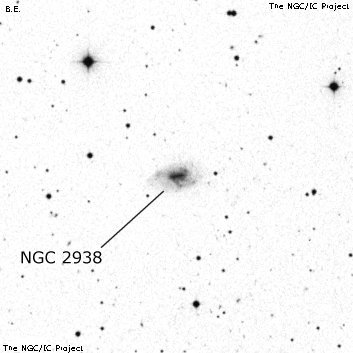NGC/IC Project Restoration Effort
(This is a very very beta version)
NGC2938


Basic Information
Location and Magnitude
Right Ascension: 9:38:24.7
Declination: +76:19:9
Constellation: DRA
Visual Magnitude: 13.5
Historic Information
Discoverer: Herschel W.
Year of discovery: 1801
Discovery aperture: 18.7
Observational
Summary description: eF, S, iF, D * f 3'
Sub-type: SBc
Corwin's Notes
=====
NGC 2938 was the first of fifteen nebulae found by WH in sweep 1096 of 2 April
1801. There was considerable confusion in the 19th century about the
identities of these galaxies, confusion still not sorted out at the time the
NGC and the ICs were published.
It was, however, mostly laid to rest in an unsigned note in MNRAS 71, 509,
1911 "Communicated by the Astronomer Royal". This gives accurate positions
for forty nebulae in the area covered by WH's sweep, and enabled Dreyer to
finally publish (in the Scientific Papers) corrected NGC identifications for
WH's galaxies.
Dreyer, however, did not give cross-identifications to all of the NGC numbers,
particularly those which came in from other observers (JH and d'A). I list
those in my note to NGC 3752 (which see), where I give a fairly detailed
account of the problem and its solution.
NGC 2938 itself has been taken as not just the galaxy UGC 5115, but as the
star that JH observed near his father's published position. This, in fact,
was Dreyer's preference expressed in the 1912 Monthly Notices paper where he
published corrections to the NGC based on his work on WH's lists for the
Scientific Papers.
However, because it is clear that WH did in fact see the galaxy -- once his
observations are corrected for the telescope misalignment, his position agrees
with that for the galaxy -- I have chosen to assign the number to the galaxy.
I have to stress, however, that this is just one interpretation of the
historical record. See NGC 3752 for more on all of this.
Finally, while well-aware that WH actually did see the galaxy, Courtney
Seligman originally chose in June 2015 to adopt Dreyer's identification of
JH's star as the correct one for NGC 2938. Here, Courtney made the reasonable
assumption that Dreyer's own corrections to the NGC represented the best way
to present the catalogue today.
I, however, have made the assumptions that Dreyer was primarily compiling and
summarizing the known observations, and that -- had he had the advantage of
today's deep sky surveys -- would have tried to give the objects actually
listed by the original observers. For almost all of the NGC objects, the two
different ways of correcting the errors will lead to the same objects. This
is obviously not the case for NGC 2938 and a few others.
While I clearly favor the second viewpoint, I've given both objects -- WH's
galaxy and JH's star -- in the big table under NGC 2938. See the notes for
h 612 (JH's star) for more on this.
Steve's Notes
=====
NGC 2938
17.5" (1/28/89): faint, fairly small, slightly elongated, even surface brightness.



